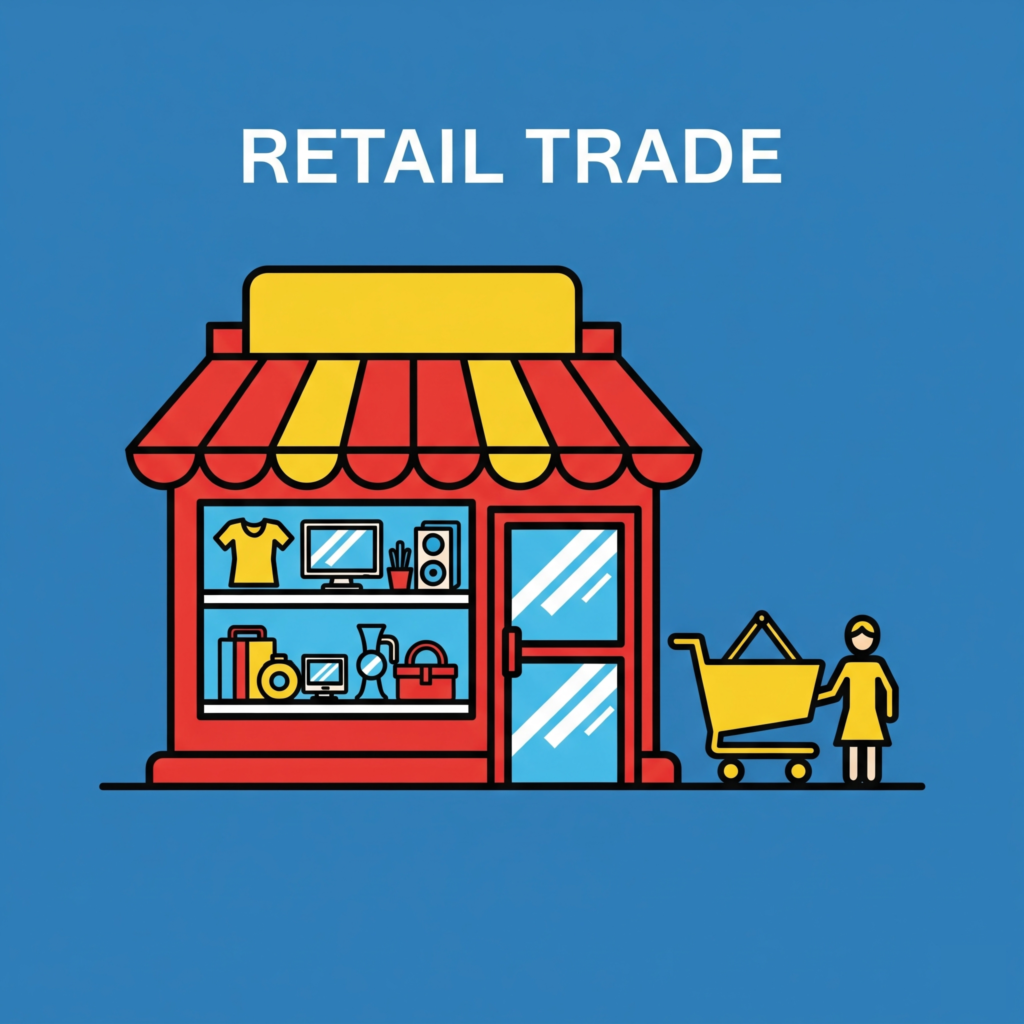Business Studies Chapter 10 Notes NCERT Class 11th
10.1 Introduction to Trade
- Definition: Trade refers to the buying and selling of goods and services with the objective of earning profit.
- Classification based on geographical location:
- Internal Trade: Trade that takes place within the boundaries of a nation.
- External Trade: Trade between two or more countries.
10.2 Internal Trade

- Definition: Buying and selling of goods and services within a nation’s boundaries.
- Key Characteristics:
- No custom duty or import duty is levied.
- Payment is generally in the legal tender of the country.
- Categories of Internal Trade:
- Wholesale Trade
- Retail Trade
- Objective: Aims at equitable distribution of goods within a nation speedily and at a reasonable cost.
10.3 Wholesale Trade
- Definition: Purchase and sale of goods and services in large quantities for the purpose of resale or intermediate use.
- Wholesalers: Traders dealing in wholesale trade.
- Role: Serve as an important link between manufacturers and retailers.
- Functions:
- Take title of goods and bear business risks.
- Purchase in bulk and sell in small lots.
- Undertake grading, packing, storage, transportation, and promotion.
- Collect market information and orders from retailers.
- Relieve retailers of maintaining large stock and extend credit facilities.
- Services of Wholesalers: Wholesalers provide time and place utility by making products available when and where needed.
10.3.1 Services to Manufacturers
- Facilitating large-scale production: Wholesalers pool small orders from retailers, enabling manufacturers to produce in bulk and achieve economies of scale.
- Bearing risk: They bear risks like price falls, theft, spoilage, and fire, relieving manufacturers.
- Financial assistance: Generally make cash payments to manufacturers for purchases and sometimes provide advances for bulk orders.
- Expert advice: Provide manufacturers with information on customer tastes, market conditions, and competitive activities.
- Help in marketing function: Manage distribution to numerous retailers, allowing manufacturers to focus on production.
- Facilitate production continuity: Purchase and store goods as they are produced, ensuring continuous production throughout the year.
- Storage: Take delivery of goods and store them, reducing the storage burden on manufacturers.
10.3.2 Services to Retailers
- Availability of goods: Make products from various manufacturers readily available to retailers, reducing the need for large inventory.
- Marketing support: Undertake advertising and sales promotional activities, helping retailers increase demand.
- Grant of credit: Extend credit facilities to regular customers, helping retailers manage working capital.
- Specialised knowledge: Share market knowledge, new product information, and advice on store decor and shelf space with retailers.
- Risk sharing: By selling in smaller quantities, wholesalers help retailers avoid risks associated with large stock, such as storage, obsolescence, and price fluctuations.
10.4 Retail Trade

- Definition: A business enterprise engaged in the direct sale of goods and services to ultimate consumers.
- Retailer: Buys goods in large quantities from wholesalers and sells them in small quantities to consumers.
- Final Stage of Distribution: Represents the point where goods are transferred from manufacturers or wholesalers to final consumers.
- Functions of a Retailer: Purchases varied products, arranges storage, sells in small quantities, bears risks, grades products, collects market information, extends credit, and promotes sales.
10.4.1 Services to Manufacturers and Wholesalers
- Help in distribution of goods: Make products available to scattered final consumers, providing place utility.
- Personal selling: Relieve producers of personal selling efforts, aiding in sales actualisation.
- Enabling large-scale operations: Free manufacturers and wholesalers from individual sales, allowing them to focus on larger scale operations.
- Collecting market information: Provide direct market insights on customer tastes, preferences, and attitudes, useful for marketing decisions.
- Help in promotion: Participate in promotional activities (e.g., advertising, incentives) to boost product sales.
10.4.2 Services to Consumers
- Regular availability of products: Ensure continuous availability of various products from different manufacturers.
- New products information: Provide information on new products, features, and arrival through displays and personal selling.
- Convenience in buying: Sell in small quantities, are usually located near residential areas, and operate for long hours, offering convenience.
- Wide selection: Keep a variety of products from different manufacturers, enabling consumers to make diverse choices.
- After-sales services: Provide services like home delivery, spare parts, and customer support, influencing repeat purchases.
- Provide credit facilities: Offer credit to regular buyers, enhancing their consumption and standard of living.
Terms of Trade
- Cash on Delivery (COD): Payment for goods or services made at the time of delivery.
- Free on Board (FOB) or Free on Rail (FOR): Seller bears all expenses up to the point of delivery to a carrier.
- Cost, Insurance and Freight (CIF): Price includes cost of goods, insurance, and freight charges up to the destination port.
- Errors and Omissions Excepted (E&OE): Used in trade documents to account for mistakes and forgotten items.
10.5 Types of Retailing Trade
- Classification Basis: Can be classified by size, ownership, merchandise handled, or fixed place of business.
- Two main categories based on fixed place of business:
- Itinerant Retailers
- Fixed Shop Retailers
10.5.1 Itinerant Retailers
- Definition: Traders without a fixed place of business, who move from place to place.
- Characteristics:
- Small traders with limited resources.
- Deal in daily-use consumer products (e.g., toiletries, fruits, vegetables).
- Focus on providing doorstep service to customers.
- Keep limited inventory at home or other places.
- Common Types in India:
- Peddlers and Hawkers: Carry products on bicycles, handcarts, or on their heads, selling non-standardised, low-value goods like toys, vegetables, fabrics.
- Market Traders: Open shops at different places on fixed days, dealing in specific merchandise (e.g., fabrics, toys) or general goods, catering to lower-income groups.
- Street Traders (Pavement Vendors): Found at high-traffic areas (e.g., railway stations), selling common consumer items like stationery, eatables, ready-made garments.
- Cheap Jacks: Petty retailers with temporary independent shops who change localities based on potential, dealing in consumer items and services.
10.5.2 Fixed Shop Retailers
- Definition: Retail shops with permanent establishments.
- Characteristics:
- Generally have greater resources and operate on a larger scale than itinerant traders.
- Deal in consumer durables and non-durables.
- Offer greater credibility and services like home delivery, guarantees, repairs, and credit facilities.
- Types based on size of operations:
- Fixed Shop Small Retailers
- Fixed Shop Large Retailers
Fixed Shop Small Retailers
- General Stores: Common in local markets and residential areas, stocking a variety of daily-need products. Open long hours and often provide credit to regular customers.
- Speciality Shops: Becoming popular in urban areas, these stores specialize in a specific line of products (e.g., children’s garments, men’s wear, electronics). Located in central places, they offer wide choice within their specialization.
- Street Stall Holders: Similar to street traders but with fixed, limited space, dealing in cheap variety goods like hosiery, toys, cigarettes.
- Second-hand Goods Shop: Deal in used goods (books, clothes, automobiles, furniture) sold at lower prices, catering to persons with modest means. Some may also stock antique items.
Fixed Shop Large Stores
- 1. Departmental Stores:
- Definition: Large establishments offering a wide variety of products classified into well-defined departments, aiming to satisfy nearly every customer’s need under one roof.
- Features:
- May provide extensive facilities like restaurants, travel bureaus, rest rooms.
- Generally located in central city areas.
- Often structured as joint-stock companies managed by a board of directors.
- Combine retailing and warehousing functions, purchasing directly from manufacturers.
- Centralized purchasing with decentralized sales.
- Advantages:
- Attract large numbers of customers due to central location.
- Convenience in buying a wide variety of goods under one roof.
- Offer attractive services like home delivery, telephone orders, credit facilities.
- Benefit from economies of large-scale operations, especially in purchasing.
- Can spend considerably on advertising and promotions, boosting sales.
- Limitations:
- Lack of personal attention due to large-scale operations.
- High operating costs leading to higher prices, less attractive to lower-income groups.
- High possibility of losses due to high costs and large inventory (e.g., fashion changes requiring clearance sales).
- Inconvenient location for quick purchases as they are centrally located.
- 2. Chain Stores or Multiple Shops:
- Definition: Networks of retail shops owned and operated by manufacturers or intermediaries, with similar appearance and merchandising strategies.
- Features:
- Located in populous localities to serve customers near their residence or workplace.
- Centralized manufacturing/procurement at a head office, leading to cost savings.
- Each shop managed by a Branch Manager who reports daily to the head office.
- All branches controlled by the head office, which formulates policies.
- Fixed prices and cash sales; cash deposited daily into local bank accounts for the head office.
- Head office appoints inspectors for supervision of quality and adherence to policies.
- Advantages:
- Economies of scale due to central procurement.
- Elimination of unnecessary middlemen by selling directly to consumers.
- No bad debts as sales are cash-based.
- Flexibility in transferring goods between shops reduces dead stock.
- Diffusion of risk: losses in one shop can be offset by profits in others.
- Lower overall operating costs due to centralized functions and increased sales.
- Flexibility to close or shift unprofitable shops without significantly affecting overall profitability.
- Limitations:
- Limited selection of goods, especially if owned by manufacturers (e.g., selling only their own products).
- Lack of initiative among personnel due to strict adherence to head office instructions.
- Mail Order Houses (Mail Order Business):
- Definition: Retail outlets that conduct business through mail, without direct personal contact between buyers and sellers.
- Process: Orders received via post, advertisements, or catalogues. Goods sent by post, rail, or vending machines upon full payment.
- Suitability of Products: Best for goods that are graded, standardized, easily transportable, have ready demand, are available in large quantities, and can be described through pictures. Not suitable for perishable or bulky goods.
- Advantages:
- Limited capital requirement as no heavy expenditure on buildings.
- Elimination of middlemen, leading to savings for both buyers and sellers.
- Absence of bad debts due to cash-only sales.
- Wide reach to all places with postal services.
- Convenience for customers as goods are delivered at their doorstep.
- Limitations:
- Lack of personal contact, leading to potential misunderstandings and mistrust.
- High promotion costs due to heavy reliance on advertisements.
- No inspection of goods before purchase by buyers.
- Delayed delivery as goods are sent by post.
- Not suitable for all types of products.
- Requires a widespread literate population for success.
- Consumer Cooperative Stores:
- Definition: Stores owned, managed, and controlled by consumers, aiming to reduce the number of middlemen.
- Objective: To provide consumer goods of good quality at reasonable prices.
- Management: Managed by an elected managing committee.
- Funding: Capital is raised through shares from members.
- Registration: Must be registered under the Cooperative Societies Act.
- Advantages:
- Ease of formation: Any ten people can form a voluntary association.
- Limited liability of members.
- Democratic management: Each member has one vote.
- Lower prices due to elimination of middlemen.
- Cash sales reduce working capital requirements.
- Convenient locations.
- Limitations:
- Lack of initiative among honorary managers.
- Shortage of funds due to limited membership.
- Lack of patronage from members.
- Lack of business training among managers.
- Super Markets:
- Definition: Large retailing units selling a wide variety of consumer goods based on low prices, wide variety, self-service, and strong merchandising appeal.
- Products: Generally food products and other low-priced, branded, and widely used consumer goods (e.g., groceries, utensils, electronic appliances).
- Location: Usually in main shopping centers.
- Features: Goods kept on racks with clear price and quality tags.
- Advantages:
- Central location attracts many customers.
- Economies of scale due to large-scale operations.
- Wide variety of products under one roof.
- No bad debts due to cash sales.
- Benefits of impulse buying due to self-service and product display.
- Limitations:
- No credit facilities, restricting purchasing power.
- No personal attention to customers due to self-service.
- Risk of mishandling goods by customers.
- High overhead expenses, which can negate low-price appeal.
- Huge capital requirement and need for high turnover, limiting viability in small towns.
- Vending Machines:
- Definition: Coin-operated machines useful for selling various products like hot beverages, tickets, milk, soft drinks, chocolates, and newspapers.
- Advantages: Provide convenience and are suitable for pre-packed low-priced products.
- Limitations: High initial installation and maintenance costs; not suitable for all products.
10.6 Role of Chambers of Commerce and Industry Associations in Promotion of Internal Trade
- Purpose: Associations like ASSOCHAM, CII, and FICCI are formed to promote and protect common business interests.
- Catalytic Role: Play a crucial role in strengthening internal trade.
- Interactions with Government: Interact at various levels to:
- Reduce hindrances to trade.
- Increase interstate movement of goods.
- Introduce transparency.
- Remove multiple layers of inspection and bureaucratic hurdles.
- Erect sound infrastructure.
- Simplify and harmonise tax structures.
- Intervention Areas:
- Interstate movement of goods: Facilitate vehicle registration, surface transport policies, and highway construction.
- Octroi and other local levies: Work to ensure these taxes do not hinder smooth transportation and local trade.
- Marketing of agro products: Associations of agriculturists help streamline local subsidies and marketing policies.
- Weights and Measures and prevention of duplication brands: Interact with the government to formulate and enforce laws protecting consumers and traders.
- Excise duty: Interact to streamline excise duties, which impact pricing.
- Promoting sound infrastructure: Discuss investments in infrastructure like roads, ports, electricity, and railways with government agencies.
- Labour legislation: Constantly interact with the government on issues related to labour laws and retrenchment.
Goods and Services Tax (GST)
- Key Features:
- Revolutionizing tax reform in India.
- Destination-based single tax on supply of goods and services.
- Replaced multiple indirect taxes levied by Central and State governments.
- Aims to unify the market.
- Expected to improve ease of doing business, reduce tax burden, improve administration, mitigate evasion, and boost revenues.
- Comprises Central GST (CGST) and State GST (SGST).
- Charged at each stage of value addition with input tax credit mechanism to avoid cascading effect (tax on tax).
- Makes luxury goods costlier and mass consumption items cheaper.
- Has a mechanism of matching invoices to check tax frauds and evasion.
- Anti-profiteering measures ensure benefits from cost reduction are passed to consumers.
- Benefits and Empowerment for Citizens:
- Reduction in overall tax burden.
- No hidden taxes.
- Development of a harmonised national market.
- Higher disposable income for education and essential needs.
- Wider choice for customers.
- Increased economic activity and employment opportunities.
- Key Features of GST:
- Applies to the whole country.
- Applicable on ‘supply’ of goods or services.
- Based on destination-based consumption tax principle.
- Import of goods and services subject to IGST and customs duties.
- CGST, SGST, and IGST rates mutually agreed upon by Centre and States.
- Four tax slabs: 5%, 12%, 18%, and 28%.
- Exports and supplies to SEZ are zero-rated.
- Various modes of tax payment available (Internet banking, debit/credit card, NEFT/RTGS).
- GST Council:
- Chairperson: Finance Minister.
- Vice Chairperson: Chosen from State Government Ministers.
- Members: MoS (Finance) and all Ministers of Finance/Taxation of each State.
- Quorum: 50% of total members.
- Weightage: States have two-thirds, Centre has one-third.
- Decision: Taken by 75% majority.
- Role: Makes recommendations on all aspects of GST, including rules and rates.






